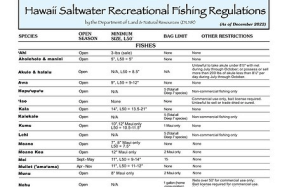Sustainable Fishing Relies on Healthy Estuaries

The mission of Hawai‘i’s Division of Aquatic Resources (DAR) is “to manage, conserve and restore the state’s unique aquatic resources and ecosystems for present and future generations.” When thinking of this, many of you may picture coral reefs, freshwater streams and diverse fisheries. Did you know that the DAR also does studies in estuaries?
What are estuaries, and why are they important? Estuaries form in coastal areas where there is mixing of fresh water with ocean water. This means that estuaries are the interface of terrestrial, freshwater and marine ecosystems. As the “melting pots” of ecosystems, estuaries are among the most biologically productive ecosystems on the planet. The exceptional productivity of estuaries attracts juvenile fish. For this reason, worldwide many species of fish use estuaries as their nursery grounds. This is why sustainable fishing relies on healthy estuaries.
Estuaries of Hawai‘i, known as muliwai, also play this important ecological service. Many near-shore sport fish settle out from the plankton to begin coastal life as fingerling
You’re reading a preview, subscribe to read more.
Start your free 30 days





